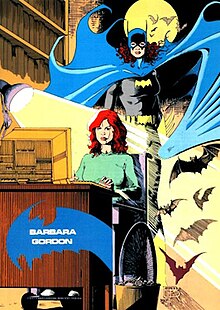| Barbara Gordon | |
|---|---|
 Batgirl and Oracle — the definitive iterations of the character. Art by Kevin Maguire and Karl Kesel, and colors by Anthony Tollin. From Who's Who In The DC Universe (vol. 1) #7 (February 1991). | |
| Publication information | |
| Publisher | DC Comics |
| First appearance | As Batgirl: Detective Comics #359 (December 31st 1966) As Oracle: Suicide Squad #23 (January 10th 1989) |
| Created by | As Batgirl: William Dozier (idea) Julius Schwartz (concept) Gardner Fox (writer) Carmine Infantino (artist) As Oracle: John Ostrander (writer) Kim Yale (writer) |
| In-story information | |
| Alter ego | Barbara Joan Gordon |
| Species | Human |
| Team affiliations | |
| Partnerships | Batman Nightwing Robin Batgirl/Orphan Batgirl/Spoiler Huntress Black Canary |
| Notable aliases | Batgirl Amy Beddoes Oracle |
| Abilities |
|
Barbara Gordon is a superheroine appearing in American comic books published by DC Comics, commonly in association with the superhero Batman. The character was created by television producer William Dozier, editor Julius Schwartz, writer Gardner Fox, and artist Carmine Infantino. Dozier, the producer of the 1960s Batman television series, requested Schwartz to call for a new female counterpart to the superhero Batman that could be introduced into publication and the third season of the show simultaneously. The character subsequently made her first comic-book appearance as Batgirl in Detective Comics #359, titled "The Million Dollar Debut of Batgirl!" in January 1967, by Fox and Infantino,[1] allowing her to be introduced into the television series, portrayed by actress Yvonne Craig, in the season 3 premiere "Enter Batgirl, Exit Penguin", in September that same year.
Barbara Gordon is the daughter of Gotham City police commissioner James Gordon, the sister of serial killer James Gordon Jr. and is initially employed as head of the Gotham City Public Library. Although the character appeared in various DC Comics publications, she was prominently featured in Batman Family which debuted in 1975, partnered with the original Robin, Dick Grayson, whom she has a history of working closely and being romantically involved with. In 1988, following the editorial retirement of the character's Batgirl persona in Batgirl Special #1, the graphic novel Batman: The Killing Joke depicts the Joker shooting her through the spinal cord in her civilian identity, resulting in paraplegia. In subsequent stories, the character was reestablished as a technical advisor, computer expert and information broker known as Oracle. Becoming a valuable asset providing intelligence and computer hacking services to assist other superheroes, she makes her first appearance as Oracle in Suicide Squad #23 (1989) and later became a featured lead of the Birds of Prey series. In 2011, as part of DC Comics The New 52 relaunch, Barbara recovered from her paralysis following a surgical procedure and returned as Batgirl. Barbara has since featured in the eponymous Batgirl monthly title as well as Birds of Prey and other Batman books. Following the events of Joker War, Barbara returned to her Oracle role while recovering from an injury, and continues to operate as both Batgirl and Oracle after the 2021 Infinite Frontier event.
The character was a popular comic book figure during the Silver Age of Comic Books, due to her appearances in the Batman television series and continued media exposure. She has achieved similar popularity in the Modern Age of Comic Books under the Birds of Prey publication and as a disabled icon. The character has been the subject of academic analysis concerning the roles of women, librarians, and disabled people in mainstream media. The events of The Killing Joke, which led to the character's paralysis, as well as the restoration of her mobility, have also been a subject of debate among comic book writers, artists, editors, and readership. Viewpoints range from sexism in comic books, to the limited visibility of disabled characters and the practicality of disabilities existing in a fictional universe where magic, technology, and medical science exceed the limitations of the real world.
As both Batgirl and Oracle, Barbara Gordon has been featured in various adaptations related to the Batman franchise, including television, film, animation, video games, and other merchandise. Aside from Craig, the character has been portrayed by Dina Meyer, Alicia Silverstone (as Barbara Wilson), and Jeté Laurence, and has been voiced by Melissa Gilbert, Tara Strong, Danielle Judovits, Alyson Stoner, Mae Whitman, Kimberly Brooks and Briana Cuoco among others. Barbara Gordon appeared in the third season of the HBO Max series Titans as the new commissioner of Gotham City portrayed by Savannah Welch.[2] The character was slated for a solo film set in the DCEU, starring Leslie Grace in the title role and intended to be released on HBO Max. The film was canceled in August 2022. In 2011, Barbara Gordon ranked 17th in IGN's "Top 100 Comic Book Heroes".[3]
- ^ McAvennie, Michael (2010), "1960s", in Dolan, Hannah (ed.), DC Comics Year By Year A Visual Chronicle, Dorling Kindersley, p. 122, ISBN 978-0-7566-6742-9,
Nine months before making her debut on Batman, a new Batgirl appeared in the pages of Detective Comics...Yet the idea she is also seen as Batman's secretary on the debut of Barbara Gordon, according to editor Julius Schwartz, was attributed to the television series executives' desire to have a character that would appeal to a female audience and for this character to originate in the comics. Hence, writer Gardner Fox and artist Carmine Infantino collaborated on "The Million Dollar Debut of Batgirl!"
- ^ "'Titans' Season 3 Casts Savannah Welch as Barbara Gordon (EXCLUSIVE)". January 19, 2021. Archived from the original on January 19, 2021. Retrieved January 19, 2021.
- ^ Top 100 Comic Book Heroes, IGN Entertainment, archived from the original on August 17, 2011, retrieved July 6, 2011